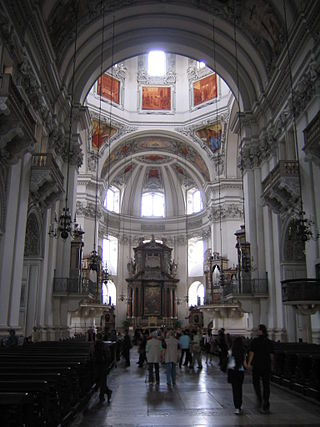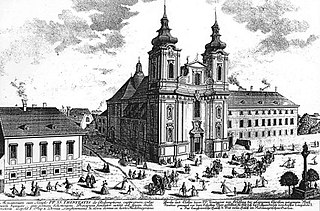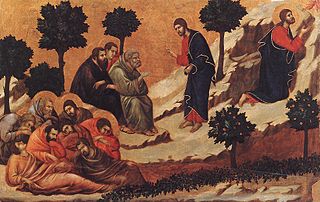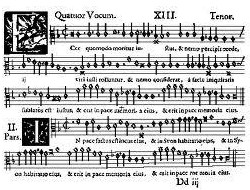
Miserere is a setting of Psalm 51 by Italian composer Gregorio Allegri. It was composed during the reign of Pope Urban VIII, probably during the 1630s, for the exclusive use of the Sistine Chapel during the Tenebrae services of Holy Week, and its mystique was increased by unwritten performance traditions and ornamentation. It is written for two choirs, of five and four voices respectively, singing alternately and joining to sing the ending in one of the most recognised and enduring examples of polyphony, in this case in a 9-part rendition.

Johann Sebastian Bach's Magnificat, BWV 243, is a musical setting of the biblical canticle Magnificat. It is scored for five vocal parts, and a Baroque orchestra including trumpets and timpani. It is the first major liturgical composition on a Latin text by Bach.

Franz Schubert composed his lied "An die Musik" in March 1817 for solo voice and piano, with text from a poem by his friend Franz von Schober. In the Deutsch catalog of Schubert's works it is number D547. The original key is D major. It was published in 1827 as Opus 88, No. 4, by Thaddäus Weigl. Schubert dedicated the song to the Viennese piano virtuoso Albert Sowinsky on April 24, 1827, a decade after he composed it.

Psalm 92 is the 92nd psalm of the Book of Psalms, beginning in English in the King James Version: "It is a good thing to give thanks unto the LORD". In the slightly different numbering system used in the Greek Septuagint and Latin Vulgate translations of the Bible, this psalm is Psalm 91. In Latin, it is known as "Bonum est confiteri Domino ". The psalm is known as Mizmor Shir L'yom HaShabbat, is ostensibly dedicated to the Shabbat day.

"Rorate caeli" or "Rorate coeli" are the opening words of Isaiah 45:8 in the Vulgate. The text appears at several points in the Christian liturgy of the Western Church during Advent.

Vesperae solennes de Dominica, K. 321, is a sacred choral composition, written by Wolfgang Amadeus Mozart in 1779. It is scored for SATB choir and soloists, violin I and II, 2 trumpets, 3 trombones colla parte, 2 timpani, and basso continuo.

Psalm 134 is the 134th psalm from the Book of Psalms, a part of the Hebrew Bible and the Christian Old Testament, beginning in English in the King James Version: "Behold, bless ye the LORD, all ye servants of the LORD". Its Latin title is "Ecce nunc benedicite Dominum". It is the last of the fifteen Songs of Ascents, and one of the three Songs of Ascents consisting of only three verses. The New King James Version entitles this psalm "Praising the Lord in His House at Night".

Vesperae solennes de confessore, K. 339, is a sacred choral composition, written by Wolfgang Amadeus Mozart in 1780. It is scored for SATB choir and soloists, violin I, violin II, 2 trumpets, 3 trombones colla parte, 2 timpani, and basso continuo.

Stabat Mater in F minor, D 383, is a musical setting of the Stabat Mater sequence, composed by Franz Schubert in 1816. It is scored for soprano, tenor and bass soloists, SATB choir, 2 flutes, 2 oboes, 2 bassoons, contrabassoon, 2 french horns, 3 trombones, violin I and II, viola, cello and double bass.

Mass No. 1 in F major, D 105, is a Mass composed by Franz Schubert in 1814. It is scored for two soprano soloists, two tenor soloists, alto and bass soloists, SATB choir, oboe, clarinet, bassoon, 2 horns, violin I and II, viola, and basso continuo. It was the first of Schubert's Masses to be performed, and is of the missa solemnis type.

Mass No. 4 in C major, D 452, is a mass composed by Franz Schubert in 1816. It was originally scored for soprano, alto, tenor and bass soloists, SATB choir, violin I and II, and basso continuo. It is classified as a missa solemnis.

Mass No. 5 in A-flat major, D 678, is a mass composed by Franz Schubert, completed in 1822. There is no record of a performance during Schubert's lifetime. It is scored for soprano, alto, tenor and bass soloists, SATB choir with divisi, violin I and II, viola, flute, 2 oboes, 2 clarinets, 2 bassoons, 2 horns, 2 trumpets, 3 trombones colla parte, timpani and basso continuo. It is classified as a missa solemnis.

Mass No. 6 in E-flat major, D 950, is a mass composed by Franz Schubert, a few months before his death. It is scored for two tenor soloists, soprano, alto and bass soloists, SATB choir with divisi, 2 oboes, 2 clarinets, 2 bassoons, 2 horns, 2 trumpets, 3 trombones, timpani, violin I and II, viola, cello, and double bass. It was Schubert's final setting of the order of Mass, and is classified as a missa solemnis.

The Magnificat by John Rutter is a musical setting of the biblical canticle Magnificat, completed in 1990. The extended composition in seven movements "for soprano or mezzo-soprano solo, mixed choir, and orchestra " is based on the Latin text, interspersed with "Of a Rose, a lovely Rose", an anonymous English poem on Marian themes, the beginning of the Sanctus and a prayer to Mary. The music includes elements of Latin American music.

Franz Schubert wrote three string trios, all of them in the key of B-flat major. From the first of these, D 111A, a trio Schubert wrote in 1814, only a few measures are extant. The string trio D 471 consists of a completed first movement and an incomplete second movement, composed in 1816. The last of these trios, D 581, was completed in four movements, exists in two versions and was composed in 1817.

The Magnificat in E-flat major, BWV 243a, also BWV 243.1, by Johann Sebastian Bach is a musical setting of the Latin text of the Magnificat, Mary's canticle from the Gospel of Luke. It was composed in 1723 and is in twelve movements, scored for five vocal parts and a Baroque orchestra of trumpets, timpani, oboes, strings and basso continuo including bassoon. Bach revised the work some ten years later, transposing it from E-flat major to D major, and creating the version mostly performed today, BWV 243.

Tristis est anima mea is the second responsory of the Tenebrae for Maundy Thursday. The Latin text refers to Christ's Agony in the Garden of Gethsemane, a part of his Passion.

The righteous perishes are the words with which the 57th chapter of the Book of Isaiah start. In Christianity, Isaiah 57:1–2 is associated with the death of Christ, leading to liturgical use of the text at Tenebrae: the 24th responsory for Holy Week, "Ecce quomodo moritur justus", is based on this text. More generally, the text is associated with the death of loved ones and is used at burials. As such, and in other versions and translations, the Bible excerpt has been set to music.

















